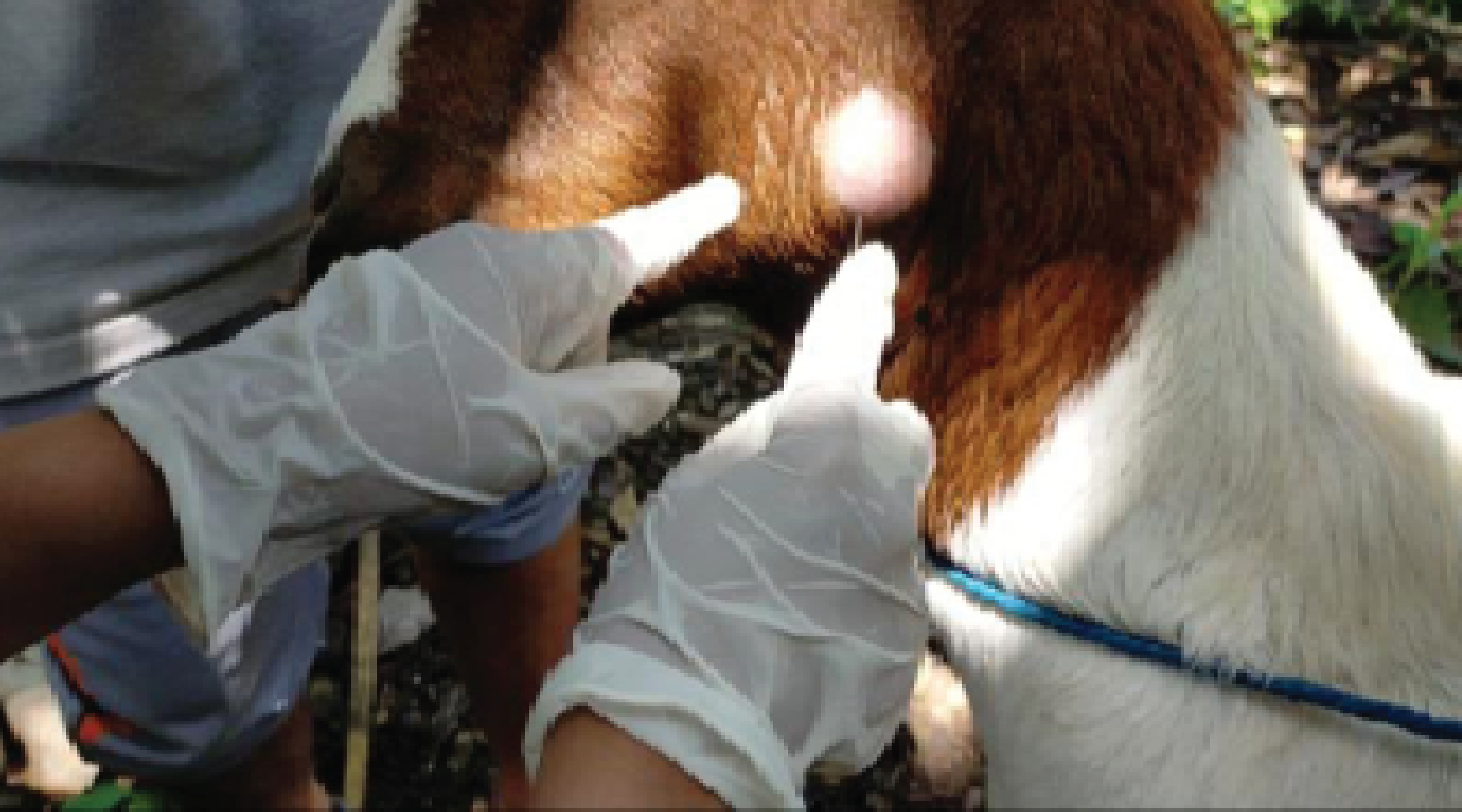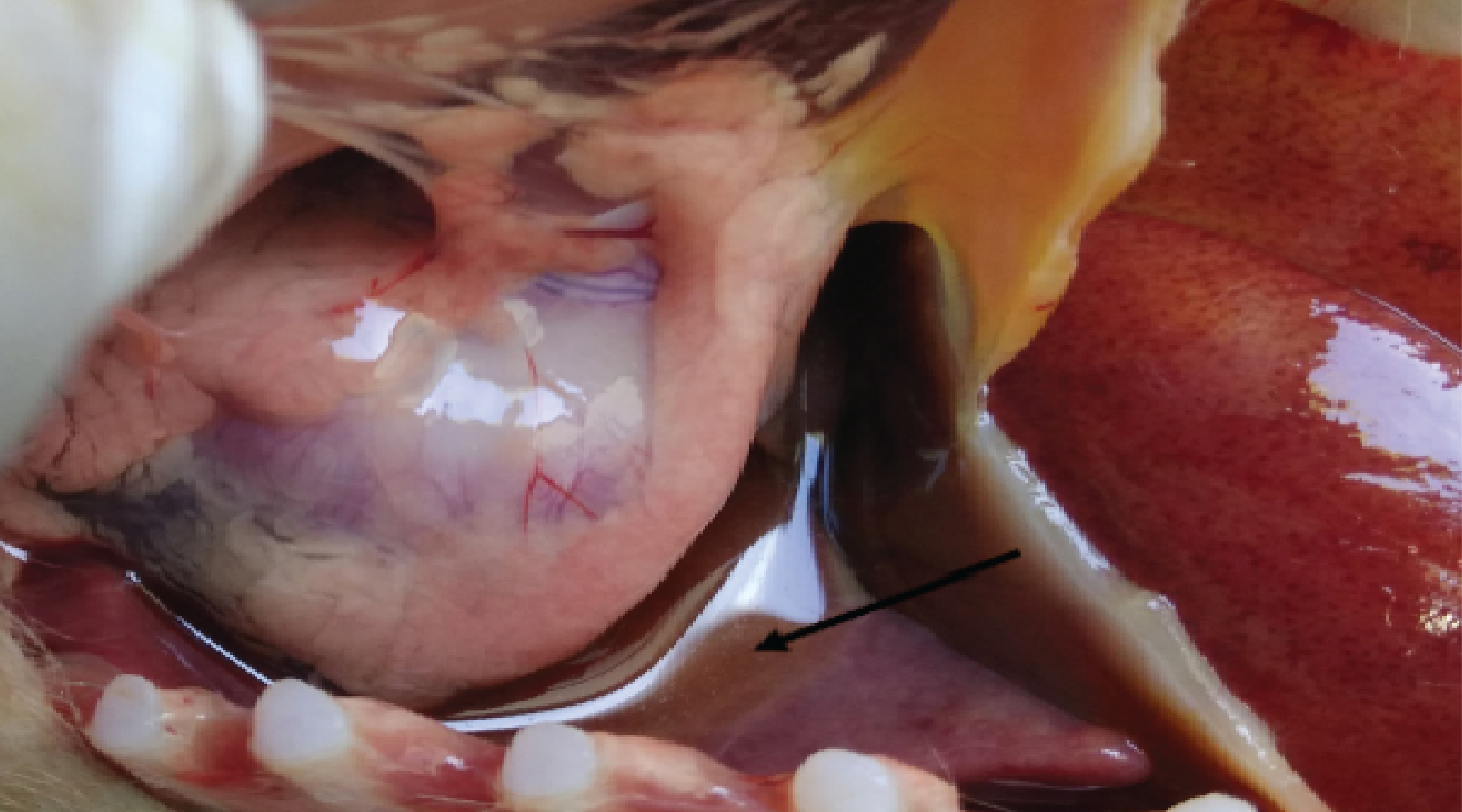Sebaceous Adenoma Case in a Golden Retriever Dog

Downloads
Background: Sebaceous adenoma is a benign tumour originating from the skin's sebaceous glands. These tumours can arise in older and middle-aged dogs, typically on various body parts, head, and extremities. The tumours can manifest as either lumps or ulcers. Ulcers may develop when the animal scratches the tumour mass. Purpose: Increase the insight and ability of veterinary practitioners in diagnosing and providing information regarding the treatment of sebaceous adenomas. Case: A nine-year-old Golden retriever dog was brought to the Bali Veterinary Clinic with a complaint of a lateral wound on the face skin of the right eye. Anamnesis revealed that the initial wound was a lump. Clinical examination showed a yellowish ulcer with a 2 cm diameter. Case Management: A hematology examination indicated mild anemia in the dog, while blood biochemistry revealed no abnormalities. Cytology confirmed that the ulcer was a sebaceous adenoma. The owner declined surgery for their pet, so treatment involved applying Bioplacenton® gel to the ulcer area to prevent further infection and accelerate wound healing. Conclusion: In this case, the ulcer wound can be concluded as a sebaceous adenoma. This tumour is benign and harmless, but it is advisable to remove the tumour mass if it impairs the animal's activity and prevents potential secondary infection.
Ayele, L., Mohammed, C., and Yimer, L., 2016. Review on Diagnostic Cytology: Techniques and Applications in Veterinary Medicine. Journal of Veterinary Science & Technology, 08 (1), 1–10.
Azevedo, R.S., Almeida, O.P., Santos Netto, J.N., Miranda, Á.M.M.A., Santos, T.C.R.B., Della Coletta, R., Ajudarte Lopes, M., and Pires, F.R., 2009. Comparative clinicopathological study of intraoral sebaceous hyperplasia and sebaceous adenoma. Oral Surgery, Oral Medicine, Oral Pathology, Oral Radiology, and Endodontology, 107 (1), 100–104.
Brown, V.R. and Bevins, S.N., 2017. A Review of virulent Newcastle Disease Viruses in the United States and The Role of Wild Birds in Viral Persistence and Spread. Veterinary Research, 48 (1), 1-15.
Cahyanti, P.Y., Widyastuti, S.K., Jayanti, P.D., Sewoyo, P.S., and Permana, R., 2023. Laporan Kasus: Ascites Disertai Distensi Vena Abdominalis Akibat Gangguan Fungsi Hati pada Anjing. Indonesia Medicus Veterinus, 12 (2), 223–232.
Chen, W.C. and Zouboulis, C.C., 2009. Hormones and the Pilosebaceous Unit. Dermato-Endocrinology, 1 (2), 81–86.
Costa, F.B.C., Silva, K.V.G.C., Leite, J.D.S., Silva, F.B.F., Batista, B.P.D.S., Silva, J.F.D.M., and Ferreira, A.M.R., 2020. Histopathological Study of Canine Sebaceous Tumors and Their Association with PCNA Expression by Immunohistochemistry. Revista Brasileira de Ciíªncia Veterinária, 27 (3), 150–158.
Ginel, P.J., Lucena, R., Millán, Y., González-Medina, S., Guil, S., García-Monterde, J., De Los Monteros, A.E., and De Las Mulas, J.M., 2010. Expression of Oestrogen and Progesterone Receptors in Canine Sebaceous Gland Tumours: Hormone Receptors in Sebaceous Gland Tumours. Veterinary Dermatology, 21 (3), 297–302.
Go, D.-M., Lee, S.-H., Woo, S.-H., and Kim, D.-Y., 2017. Intra-oral Sebaceous Gland Tumours in Two Dogs. Journal of Comparative Pathology, 157 (4), 296–298.
Jakab, C., 2003. Histopathological Analysis of Tumours of the Sebaceous Gland in Spaniels. Kisallat Praxis, 4, 36–38.
Jazaerly, T., Bandyopadhyay, S., Almardini, N., and Husain, M., 2014. Diagnosis of Sebaceous Lymphadenoma by Fine Needle Aspiration in a Patient with Cowden Syndrome: Case Report and Review of the Literature. CytoJournal, 11, 25.
Lesnik, R.H., Kligman, L.H., and Kligman, A.M., 1992. Agents that Cause Enlargement of Sebaceous Glands in Hairless Mice. II. Ultraviolet Radiation. Archives of Dermatological Research, 284 (2), 106–108.
Marques"da"Costa, J., Campos"do"Carmo, G., Ormiga, P., Ishida, C., Cuzzi, T., and Ramos"e"Silva, M., 2015. Sebaceous Adenoma: Clinics, Dermatoscopy, and Histopathology. International Journal of Dermatology, 54 (6), 200-202.
Ozyigit, M.O., Akkoc, A., and Yilmaz, R., 2005. Sebaceous Gland Adenoma in a Dog. Turkish Journal of Veterinary and Animal Sciences, 29 (5), 1213–1216.
Pakhrin, B., Kang, M.-S., Bae, I.-H., Park, M.-S., Jee, H., You, M.-H., Kim, J.-H., Yoon, B.-I., Choi, Y.-K., and Kim, D.-Y., 2007. Retrospective Study of Canine Cutaneous Tumors in Korea. Journal of Veterinary Science, 8 (3), 229-236.
Parmar, J.J., Shah, A., Rao, N., Godasara, D., and Patel, D., 2019. Successful Surgical Management of Sebaceous Gland Tumours in Dogs. The Indian Journal of Veterinary Sciences and Biotechnology, 15 (2), 78–80.
Rebar, A.H., 2008. Cytology of Lumps and Bumps. World Small Animal Veterinary Association Congress Proceedings. West Lafayette, USA.
Sabattini, S., Bassi, P., and Bettini, G., 2015. Histopathological Findings and Proliferative Activity of Canine Sebaceous Gland Tumours with a Predominant Reserve Cell Population. Journal of Comparative Pathology, 152 (2–3), 145–152.
Sananmuang, T., Jeeratanyasakul, P., Mankong, K., and Rattanapinyopituk, K., 2016. Canine Sebaceous Adenoma of External Genitalia: Case Report. Journal of Applied Animal Science, 9 (3), 51–56.
Sewoyo, P.S., Adi, A.A.A.M., Setiasih, N.L.E., Dewi, I.G.A.M., 2022. Haematological Profile of Rat Fibrosarcoma Models after Virulent Newcastle Disease Virus Virotherapy: A Pilot Study. Revista Electronica de Veterinaria 23, 47-55.
Simeonov, R., 2011. Quantitative Cytomorphology as an Additional Tool for Differentiation Between Canine Cutaneous Sebaceous Adenomas and Sebaceous Carcinomas. Trakia Journal of Sciences, 9 (1), 83–87.
Villalobos, A.E., 2021. Epidermal and Hair Follicle Tumors in Animals. MSD Manual. Veterinary Manual. Available from:https://www.msdvetmanual.com/integumentary-system/tumors-of-the-skin-and-softtissues/epidermal-and-hair-follicle-tumors-in-animals. Accessed: 17 Mei 2023.
Whitbread, T.J., 2015. Cytology. MSD Manual. Veterinary Manual. Available from: https://www.msdvetmanual.com/clinicalpathology-and-procedures/diagnostic- procedures-for-the-private-practicelaboratory/cytology. Accessed: 2 September 2023.
Copyright (c) 2023 Author(s)

This work is licensed under a Creative Commons Attribution-ShareAlike 4.0 International License.
- The journal allows the author to hold the copyright of the article without restrictions.
- The journal allows the author(s) to retain publishing rights without restrictions.
- The legal formal aspect of journal publication accessibility refers to Creative Commons Attribution Share-Alike (CC BY-SA).

Journal of Applied Veterinary Science and Technology is licensed under a Creative Commons Attribution-ShareAlike 4.0 International License




























